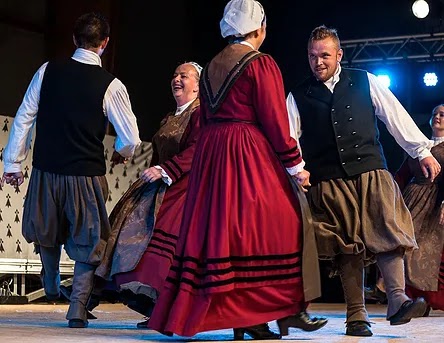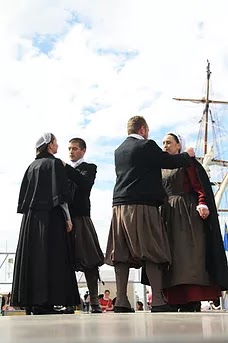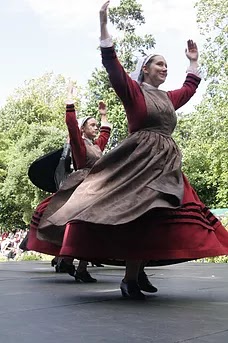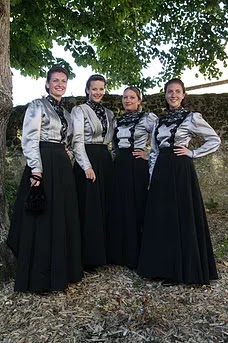Hello all,
Today I will continue my look at the costumes of the Gwenrann region of Nantes Province.
Pays Nantais in French
Bro Naoned in Breton
Paeï de Nàntt in Gallo
The province of Nantes has always been an integral part of Brittany. When the French government instituted the current administrative divisions called departments, The Province of Nantes was renamed the department of Loire Atlantic, with similar borders. When the departments were grouped into regions, however, Loire Atlantic was taken away from Brittany and attached to a new group called Pays de la Loire. Neither the Breton people or the Nantais have recognized this, and continue to lobby that it be officially returned. This is why some modern maps of Brittany do not include this province.
This province has historically had three languages. Breton was the majority language on the Guerande peninsula into the 20th century, and there are currently efforts to revive it. In most of the rest of the Province, Gallo was spoken. In the southern part of Retz, the local language was Poitevan.
BrHo Gwennrann or Pay Guérandais
The peninsula has always had a unique culture, and the costumes here are very different from those in the rest of Nantais. Breton was the majority language here until recently, and this may be considered part of Lower Brittany. Here is a physical map of the peninsula.
The most important feature that you will notice is the sharp escarpment which runs from the northwest to the southeast. The city of Gwennrann or Guérande is located in the middle of this ridge. The the south lie the 'white lands', the salt marshes, home of the people that the French call Paludier, and north lie the 'black lands', the peat bogs, home of the people that the French call Metayer. On the peninsula in the southwest, two cities form their own distinct costume areas within this region; Croisic and Pouliguen. Here is Guesdon's map of these costume areas, which is more detailed and accurate than Creston's.
1. The Swamp Dwellers, [Paludier], including the towns of Batz and Guerande, as well as many villages in the area, consisting of the salt marshes and the land immediately surrounding them.
2. The Bog Dwellers, [Metayer], including the town of Escoublac and the black lands north of the escarpment.
3. The town of Croisic.
4. The town of Pouliguen.
The Bog Dwellers - Metayer
The costume of the Metayer is less flamboyant than that of the Paludiers. The men wear a big round hat, but less large than that of the Swamp Dwellers. They also wear a long vest, two layered jackets, full knee breeches, and gaiters, but in dark colors like brown. The cut of the jackets is somewhat different.
The women wear an outfit that closely resembles that of the city version of the Paludiers, but they have a different coif. The undercoif used is like that of the Swamp Dwellers. Take a look at the little girl in the drawing above, you will see that she is wearing the coif with the lappets down. Historically the coif was once larger. As in many costumes in both Brittany and France, the shoulder shawl must be pinned just so. Like the men, the women also tend to wear darker colors than the Paludiers.
A few more images of this costume.
The cities have their own costume tradition, related to that of Belle Île rather than the surrounding countryside. Croisic and Pouliguen have similar traditional outfits, but somewhat different coifs. Here are the coifs of Croisic, Pouliguen and Belle Île.
Here are some images of the costume of Croisic.
Just a couple images from Pouliguen.
This image is from the city of Quimiac, to the north.
And this concludes the costumes of Gwenrann.
Thank you for reading, I hope that you have found this to be interesting and informative.
Roman K.
email: rkozakand@aol.com
Source Material:
Victor Lhuer, 'Les Costumes Bretons', 2001
Pierre Jakez Helias, 'Coiffes et Costumes de Bretagne', Chateaulin, 1983
Josepj Jigourel & Yanna Fournier, 'Costumes de Bretagne', Brest, 2000
Bruno Helias, 'Breton Costumes', Florence, 1997
Yann Guesdon, 'Costumes de Bretagne', Quimper, 2011
Yann Guesdon, 'Coiffes de Bretagne', Spezet, 2014
R. Y. Creston, 'Le Costume Breton', Paris, 1974
Charles Freger, 'Portraits in Lace - Breton Women', London, 2015
Jean-Pierre Gonidec, 'Coiffes et Costumes des Bretons', Spezet, 2021
Pierre Rochereau, ' Coiffes et Costumes des Bords de Rance', Dinan, 1989
Simone Morand, 'Coiffes et Costumes de l'Ancien Comte de Rennes', Quimper, 1979





















































I love your blog its very in depth and informative unlike a lot of sites on this subject. Here's a link to my VK account https://vk.com/id628954772 I've shared quite a few pdfs on VK about the traditional costumes of different peoples from Russia. Most of them from the volga region. Keep up the good work!
ReplyDeleteCostumi molto belli!
ReplyDeleteWe always love to read about the traditional dresses. Kidoriman also provides the best quality Japanese tradition's clothes. know more at kidoriman review
ReplyDelete